
01
超高性能水泥复合钢管(UHPCC-FST)
接触爆炸后的残余抗震性能试验研究
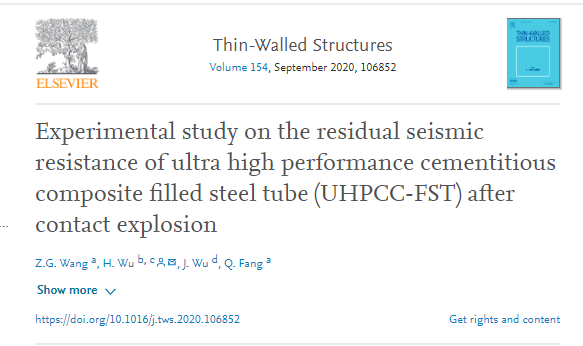
Abstract:
This paper aims to ex perimentally study the residual seismic resistance (RSR) of Ultra high performance cementitious composite filled steel tube (UHPCC-FST) specimen after contact explosion. Firstly, six 1/4 scaled circular UHPCC-FST were fabricated with the column height, outer diameter and core concrete compressive strength being 2000 mm, 203 mm and 131.5 MPa, respectively. Then, four of which were tested under contact explosion, in which the TNT charge weights were 1–3 kg and the height of bursts are all 250 mm. Furthermore, the RSR of both four post-blast UHPCC-FST columns and two intact control specimens were examined through the low-frequency horizontal cyclic loading test, in which two perpendicular loading directions were considered. It indicates that: (i) UHPCC-FST column suffered the localized cratering damage beneath the explosive, and the damage level became more severe with increasing the TNT charge weight; (ii) all the specimens endured the bending failure under the cyclic loadings, which occurred near the column bottom and cratering position for intact and post-blast specimens, respectively; (iii) RSR of the post-blast column deteriorated more obviously for the cyclic loading direction being perpendicular to the cratering face compared to that being parallel to the cratering face. Finally, based on the quantitative degradation of the seismic resistance, stiffness and energy consumption of the present UHPCC-FST specimens, a composite damage index was proposed to evaluate the RSR of the post-blast column after contact explosion. The present work could provide helpful references in the damage assessment and retrofitting of the post-blast column under potential contact explosions in the seismic zone.
原文链接:
https://www.sciencedirect.com/science/article/abs/pii/S0263823120307308
02
轴向荷载下注浆连接的数值模拟与参数分析
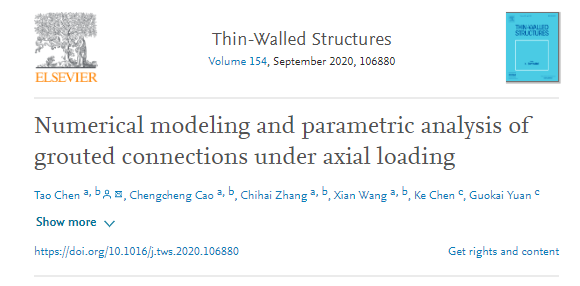
Abstract:
With the rapid development of the offshore wind power industry, large-diameter grouted connections (GCs) with high-strength grout have become a developing trend. Previous studies on ordinary-strength and small-scale GCs may not meet current engineering needs. A numerical study was carried out to investigate how the axial mechanical properties of a large-diameter GC that has high-strength grout are influenced by geometric parameters, such as radial stiffness, the height to space ratio (h/s) of shear keys, and the length to diameter ratio (Lg/Dp). The finite element model was verified against the results of the experimental test. The mechanical properties of ultimate bearing capacity, interface transfer strength, ductility, nominal average stress and grout contact pressure distribution are discussed in detail. The results suggest that the increase in radial stiffness can strengthen the axial ultimate bearing capacity and ductility of the GC. Besides, the h/s of the shear keys can affect the ultimate bearing capacity and ductility of GC by influencing the number of diagonal compression struts. Although the Lg/Dp can significantly improve the axial ultimate bearing capacity of GCs, conversely, the interface transfer strength is continuously reduced. The research results can provide technical reference for the design of GCs in the offshore wind turbine industry.
原文链接:
https://www.sciencedirect.com/science/article/abs/pii/S0263823120307588
03
柱损情况下不同钢中间矩框架连接的研究

Abstract:
This paper investigated experimentally the progressive collapse risk of three one-third scale single story, two-bay steel frames under column-loss event. Progressive collapse was simulated by applying a vertical loading on the middle column. In these tests, three different types of steel beam-to-column connections were studied. These included: one shear-connection specimen that signified the prevalent type of steel beam-column joints, and two different steel intermediate moment frame (IMF) connections conforming to ANSI/AISC 358–16. The three tested specimens along with another two 2D steel frames with IMF connection, tested in the literature, were used to calibrate 3D finite element (FE) models prepared using ABAQUS software. The validated FE models were then employed to investigate the risk of progressive collapse for eleven different types of steel IMF beam-column joints under middle column-loss scenario. Out of the eleven specimens, eight connections were designed as per ANSI/AISC 358–16; two joints were in accordance with EN 1993-Eurocode 3 and the last connection was in conformance with the 2007 Turkish-Earthquake Code (TEC-2007). Performance of different IMF connections was compared based on their modes of failure and load-displacement response in both flexural and catenary action stages.
原文链接:
https://www.sciencedirect.com/science/article/abs/pii/S0263823120307539
04
具有减小的网格灵敏度的隐式和显式求解器的双轴钢筋混凝土本构模型
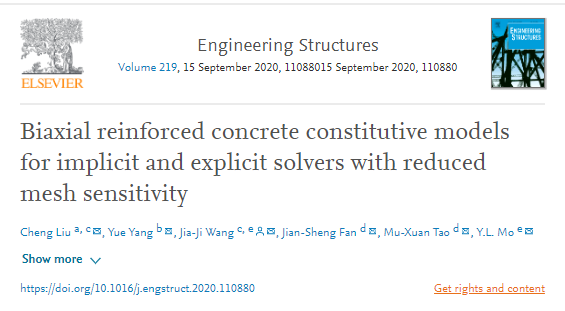
Abstract:
A new set of constitutive models named TsingHua University Concrete 2D (THUC2) is developed for use in ABAQUS. THUC2 has reduced mesh sensitivity and is based on the decoupling assumption and the fixed-angle crack assumption in order to consider the pinching effect, confinement, strength degradation, and shear softening of concrete. In the developed biaxial reinforced concrete models, the uniaxial model is first established, and the biaxial model is subsequently assembled from the uniaxial model. First, the proposed uniaxial constitutive model of concrete is reported. The mesh sensitivity of the model is reduced by adjusting the descending branch of the concrete model based on mesh size. Second, a total of five biaxial constitutive models of concrete are reported to cover a wide range of simulation requirements in engineering design. Third, the numerical implementation of the proposed concrete model in both ABAQUS implicit and explicit solvers is discussed. Subsequently, the modified two-way fixed angle crack model is validated by monotonic and hysteretic panel tests. The FE model exhibits little mesh sensitivity when the element number increased from 4 to 400. The developed model accurately predicts the pinching effect and the softening effect of the panels. Finally, previous tests on two nuclear containment vessels under lateral loads are simulated, and the modified two-way fixed angle crack model demonstrates adequate accuracy in terms of predicting the initial stiffness, ultimate capacity, and pinching effect. The proposed subroutine package for simulating RC members includes the dominant mechanical behaviors of concrete and can be adopted for high-efficiency simulation of RC shear wall structures.
原文链接:
https://www.sciencedirect.com/science/article/abs/pii/S0141029620310592
05
轻型木剪力墙结构侧向荷载分析的简化数值方法
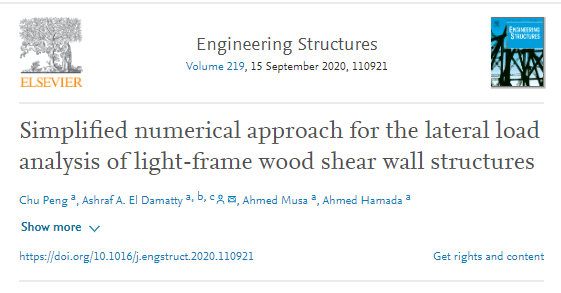
Abstract:
Increasing global demand for a sustainable society is driving the development of multi-storey light-frame wood structures, yet their complex structural components make detailed finite element modelling (FEM) impractical. The structural response of these buildings cannot typically be accurately captured with traditional simplified computational methods that rely on the use of parameter-based spring hysteretic properties or mathematical derivation. This paper proposes a powerful simplified nonlinear FEM procedure capable of accurately and efficiently capturing the responses of single-storey and multi-storey light-frame wood shear wall structures with respect to lateral displacement against base shear. The proposed procedure involves the separation of flexural and shear deformations from the total deformation resulting from the detailed model pushover analysis. The nonlinear curves of these deformation components against base shear are used to develop the properties of simplified axial and shear link models based on an approach equating external and internal work. To demonstrate the accuracy of the simplified FEM in conducting pushover analysis for structures with different structural details, 6 single-storey shear walls and 4 four-storey shear walls were modelled using this nonlinear simplified FEM analysis procedure. Compared with detailed FEM procedure, the developed simplified FEM method accurately captured the pushover analysis results with acceptable discrepancies and significantly less computational time. This proposed simplified procedure has the potential for wide applicability in structural design and analysis through the establishment of a simplified model database and the embedment of this database into any commonly used commercial FEM software.
原文链接:
https://www.sciencedirect.com/science/article/abs/pii/S0141029619352356
06
细化对高强度钢筋混凝土(HSS-RC)梁的爆炸和爆炸后回弹力的影响

Abstract:
This paper examines the influence of reinforcement detailing and fibers on the static and blast performance of beams built with high-strength concrete (HSC) and high-strength (HS) steel reinforcement. The beams in this study had dimensions of 125 mm × 250 mm × 2440 mm (b × d × L), and were built with HSC and Grade 690 MPa ASTM A1035 reinforcement. Longitudinal reinforcement in tension consisted of either 2-No.4 or 2-No.5 high-strength bars (ρ = 1% or 1.5%), while transverse reinforcement consisted of closed ties or open-stirrups made from 6 mm wire arranged at various spacing (s). Group A beams (6 specimens) were designed according to modern blast standards, with top continuity bars and closely spaced ties at s = 50 mm (d/4) throughout the beam span, while Group B beams (2 specimens) were designed with high-strength fiber-reinforced concrete (HSFRC) and a larger tie spacing of s = 100 mm (d/2). The performance of the beams is compared to that of a control set of singly-reinforced beams with “nominal detailing” consisting of open-stirrups spaced at s = 100 mm (d/2) in the shear spans only - Group C. Blast tests were conducted using a shock-tube with companion beams tested under quasi-static four-point bending. The use of blast detailing in Group A is found to significantly enhance the ductility of the high-strength steel reinforced concrete beams under static loading, allowing for full utilization of the high-strength bars in tension. Improved detailing also leads to important enhancements in blast behavior, including better control of displacements, increased blast capacity and high damage tolerance when compared to the Group C control specimens. Moreover, the results from Group B demonstrate that fibers can be used to relax transverse steel detailing without compromising ductility or performance under both static and blasts loads. The ability of high-strength steel to reduce steel requirements is also demonstrated. Moreover, the post-blast performance of the beams is assessed through residual static testing of the blast-damaged beams. The results show that blast detailing and fibers allow for significant residual post-blast resistance and energy-absorption capacity. As part of the analytical study the blast response of the test beams is predicted using 2D finite element (FE) modelling. The results show that the FE procedure which employed the Disturbed Stress Field Model was able to accurately capture the peak load and failure mode of the beams under static conditions. Under blast loading, the model also captured the displacement response of the beams up to first peak, however the accuracy reduced at subsequent cycles, with the results found to be sensitive to the choice of damping coefficients.
原文链接:
https://www.sciencedirect.com/science/article/abs/pii/S0141029619339707

















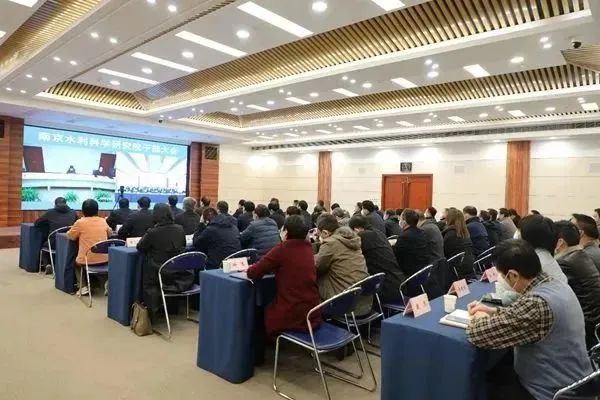







 上一篇
上一篇










